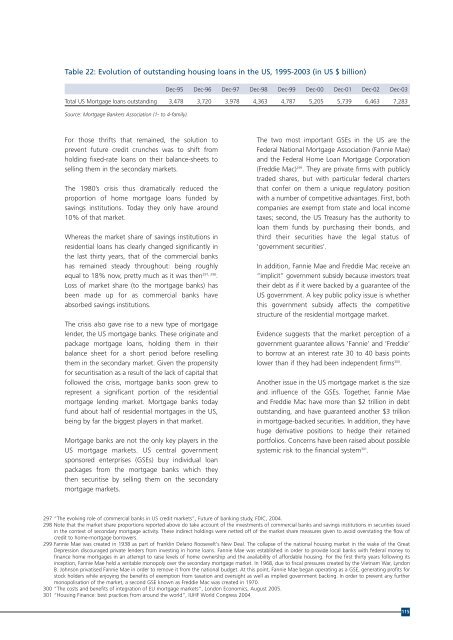A comparative analysis of the US and EU retail banking markets - Wsbi
A comparative analysis of the US and EU retail banking markets - Wsbi
A comparative analysis of the US and EU retail banking markets - Wsbi
Create successful ePaper yourself
Turn your PDF publications into a flip-book with our unique Google optimized e-Paper software.
Table 22: Evolution <strong>of</strong> outst<strong>and</strong>ing housing loans in <strong>the</strong> <strong>US</strong>, 1995-2003 (in <strong>US</strong> $ billion)<br />
Dec-95 Dec-96 Dec-97 Dec-98 Dec-99 Dec-00 Dec-01 Dec-02 Dec-03<br />
Total <strong>US</strong> Mortgage loans outst<strong>and</strong>ing 3,478 3,720 3,978 4,363 4,787 5,205 5,739 6,463 7,283<br />
Source: Mortgage Bankers Association (1- to 4-family).<br />
For those thrifts that remained, <strong>the</strong> solution to<br />
prevent future credit crunches was to shift from<br />
holding fixed-rate loans on <strong>the</strong>ir balance-sheets to<br />
selling <strong>the</strong>m in <strong>the</strong> secondary <strong>markets</strong>.<br />
The 1980’s crisis thus dramatically reduced <strong>the</strong><br />
proportion <strong>of</strong> home mortgage loans funded by<br />
savings institutions. Today <strong>the</strong>y only have around<br />
10% <strong>of</strong> that market.<br />
Whereas <strong>the</strong> market share <strong>of</strong> savings institutions in<br />
residential loans has clearly changed significantly in<br />
<strong>the</strong> last thirty years, that <strong>of</strong> <strong>the</strong> commercial banks<br />
has remained steady throughout: being roughly<br />
equal to 18% now, pretty much as it was <strong>the</strong>n 297, 298 .<br />
Loss <strong>of</strong> market share (to <strong>the</strong> mortgage banks) has<br />
been made up for as commercial banks have<br />
absorbed savings institutions.<br />
The crisis also gave rise to a new type <strong>of</strong> mortgage<br />
lender, <strong>the</strong> <strong>US</strong> mortgage banks. These originate <strong>and</strong><br />
package mortgage loans, holding <strong>the</strong>m in <strong>the</strong>ir<br />
balance sheet for a short period before reselling<br />
<strong>the</strong>m in <strong>the</strong> secondary market. Given <strong>the</strong> propensity<br />
for securitisation as a result <strong>of</strong> <strong>the</strong> lack <strong>of</strong> capital that<br />
followed <strong>the</strong> crisis, mortgage banks soon grew to<br />
represent a significant portion <strong>of</strong> <strong>the</strong> residential<br />
mortgage lending market. Mortgage banks today<br />
fund about half <strong>of</strong> residential mortgages in <strong>the</strong> <strong>US</strong>,<br />
being by far <strong>the</strong> biggest players in that market.<br />
Mortgage banks are not <strong>the</strong> only key players in <strong>the</strong><br />
<strong>US</strong> mortgage <strong>markets</strong>. <strong>US</strong> central government<br />
sponsored enterprises (GSEs) buy individual loan<br />
packages from <strong>the</strong> mortgage banks which <strong>the</strong>y<br />
<strong>the</strong>n securitise by selling <strong>the</strong>m on <strong>the</strong> secondary<br />
mortgage <strong>markets</strong>.<br />
The two most important GSEs in <strong>the</strong> <strong>US</strong> are <strong>the</strong><br />
Federal National Mortgage Association (Fannie Mae)<br />
<strong>and</strong> <strong>the</strong> Federal Home Loan Mortgage Corporation<br />
(Freddie Mac) 299 . They are private firms with publicly<br />
traded shares, but with particular federal charters<br />
that confer on <strong>the</strong>m a unique regulatory position<br />
with a number <strong>of</strong> competitive advantages. First, both<br />
companies are exempt from state <strong>and</strong> local income<br />
taxes; second, <strong>the</strong> <strong>US</strong> Treasury has <strong>the</strong> authority to<br />
loan <strong>the</strong>m funds by purchasing <strong>the</strong>ir bonds, <strong>and</strong><br />
third <strong>the</strong>ir securities have <strong>the</strong> legal status <strong>of</strong><br />
‘government securities’.<br />
In addition, Fannie Mae <strong>and</strong> Freddie Mac receive an<br />
“implicit” government subsidy because investors treat<br />
<strong>the</strong>ir debt as if it were backed by a guarantee <strong>of</strong> <strong>the</strong><br />
<strong>US</strong> government. A key public policy issue is whe<strong>the</strong>r<br />
this government subsidy affects <strong>the</strong> competitive<br />
structure <strong>of</strong> <strong>the</strong> residential mortgage market.<br />
Evidence suggests that <strong>the</strong> market perception <strong>of</strong> a<br />
government guarantee allows ‘Fannie’ <strong>and</strong> ‘Freddie’<br />
to borrow at an interest rate 30 to 40 basis points<br />
lower than if <strong>the</strong>y had been independent firms 300 .<br />
Ano<strong>the</strong>r issue in <strong>the</strong> <strong>US</strong> mortgage market is <strong>the</strong> size<br />
<strong>and</strong> influence <strong>of</strong> <strong>the</strong> GSEs. Toge<strong>the</strong>r, Fannie Mae<br />
<strong>and</strong> Freddie Mac have more than $2 trillion in debt<br />
outst<strong>and</strong>ing, <strong>and</strong> have guaranteed ano<strong>the</strong>r $3 trillion<br />
in mortgage-backed securities. In addition, <strong>the</strong>y have<br />
huge derivative positions to hedge <strong>the</strong>ir retained<br />
portfolios. Concerns have been raised about possible<br />
systemic risk to <strong>the</strong> financial system 301 .<br />
297 “The evolving role <strong>of</strong> commercial banks in <strong>US</strong> credit <strong>markets</strong>”, Future <strong>of</strong> <strong>banking</strong> study, FDIC, 2004.<br />
298 Note that <strong>the</strong> market share proportions reported above do take account <strong>of</strong> <strong>the</strong> investments <strong>of</strong> commercial banks <strong>and</strong> savings institutions in securities issued<br />
in <strong>the</strong> context <strong>of</strong> secondary mortgage activity. These indirect holdings were netted <strong>of</strong>f <strong>of</strong> <strong>the</strong> market share measures given to avoid overstating <strong>the</strong> flow <strong>of</strong><br />
credit to home-mortgage borrowers.<br />
299 Fannie Mae was created in 1938 as part <strong>of</strong> Franklin Delano Roosevelt's New Deal. The collapse <strong>of</strong> <strong>the</strong> national housing market in <strong>the</strong> wake <strong>of</strong> <strong>the</strong> Great<br />
Depression discouraged private lenders from investing in home loans. Fannie Mae was established in order to provide local banks with federal money to<br />
finance home mortgages in an attempt to raise levels <strong>of</strong> home ownership <strong>and</strong> <strong>the</strong> availability <strong>of</strong> affordable housing. For <strong>the</strong> first thirty years following its<br />
inception, Fannie Mae held a veritable monopoly over <strong>the</strong> secondary mortgage market. In 1968, due to fiscal pressures created by <strong>the</strong> Vietnam War, Lyndon<br />
B. Johnson privatised Fannie Mae in order to remove it from <strong>the</strong> national budget. At this point, Fannie Mae began operating as a GSE, generating pr<strong>of</strong>its for<br />
stock holders while enjoying <strong>the</strong> benefits <strong>of</strong> exemption from taxation <strong>and</strong> oversight as well as implied government backing. In order to prevent any fur<strong>the</strong>r<br />
monopolisation <strong>of</strong> <strong>the</strong> market, a second GSE known as Freddie Mac was created in 1970.<br />
300 “The costs <strong>and</strong> benefits <strong>of</strong> integration <strong>of</strong> <strong>EU</strong> mortgage <strong>markets</strong>”, London Economics, August 2005.<br />
301 “Housing Finance: best practices from around <strong>the</strong> world”, IUHF World Congress 2004<br />
115
















